Design Optimization of Cesium Contents for Mixed Cation MA1−xCsxPbI3-Based Efficient Perovskite Solar Cell
Abstract
1. Introduction
2. Device Models for Simulation
2.1. Simulation Software
2.2. Device Architecture of the Proposed Devices
- (i)
- Device A (TiO2/MAPbI3/spiro-OMeTAD),
- (ii)
- Device B (TiO2/MA0.75Cs0.25PbI3/spiro-OMeTAD),
- (iii)
- Device C (TiO2/MA0.5Cs0.5PbI3/spiro-OMeTAD),
- (iv)
- Device D (TiO2/MA0.25Cs0.75PbI3/ spiro-OMeTAD),
- (v)
- Device E (TiO2/CsPbI3/spiro-OMeTAD),
2.3. Simulation Materials Parameters
2.4. Simulation Device Models
2.4.1. Poisson’s Equation
2.4.2. Continuity Equation
2.4.3. Charge Transport Model
2.4.4. Photon Absorption Model
2.5. Simulation Steps
- Step 1: Set up the simulation environment on SCAPS-1D. First, set up the simulation by defining the layers of the device along with their respective standard environments, geometries, and physical parameters to initialize the software.
- Step 2: Extract the parameter information of novel parameters from literature, by examining the literature [44,45,46,47,48,49,50,51,52,53,54,55], determine the optimal physical and material input parameters for the perovskite absorbing layer as well as the charge transport layers necessary for executing a significant simulation.
- Step 3: Roughly assess the ranges of various parameters to initialize the simulation process and recommend the thickness range and doping density for each layer of the devices for each of the considered devices as per literature.
- Step 4: Roughly estimate the typical values for various physical and material parameters to initialize the simulation process, recommend the estimation of initial values for various physical and material parameters to initialize the simulation process for each layer of the device for each of the considered devices. This is the most time-consuming process.
- Step 5: Optimize and assess photovoltaic parameters as a function of electron transport layer’s thickness; execute multiple rounds of simulations to ascertain the optimal photovoltaic characteristics for all devices as a function of TiO2 thickness.
- Step 6: Optimize and assess photovoltaic parameters as a function of electron transport layer’s doping density; determine each device’s optimal photovoltaic properties as a function of TiO2 doping density by running several simulations.
- Step 7: Optimize and assess photovoltaic parameters as a function of hole-transport layer thickness; conduct a series of simulations to ascertain the optimal photovoltaic characteristics based on the thickness of spiro-OMeTAD.
- Step 8: Optimize and assess photovoltaic parameters as a function of hole-transport layer doping density; conduct a series of simulations to ascertain the optimal photovoltaic characteristics of each device, based on the doping density of spiro-OMeTAD.
- Step 9: Optimize and assess photovoltaic parameters as a function of absorber layer thickness for each device. Conduct a series of simulations to ascertain the optimal thickness of the perovskite absorber layer for each device. This process aims to identify the configuration that yields the highest power conversion efficiency and quantum efficiency. Subsequently, revise to incorporate the optimal thickness of the absorber for subsequent simulations.
- Step 10: Determine the final photocurrent-voltage response and parameters of the optimal devices by performing a series of simulations to determine the photovoltaic current-voltage response and other photovoltaic parameters of all the optimal devices of each device.
- Step 11: Estimate the final photovoltaic parameters of the optimal photovoltaic devices and calculate the ultimate photovoltaic parameters, especially power conversion efficiency for all optimal devices.
- Step 12: The simulation is terminated.
3. Results and Discussion
3.1. Thickness Optimization of Electron Transport Layer
3.2. Doping Optimization of Electron Transport Layer
- The defect chemistry of TiO2 is highly complex, involving various types of point defects and their interactions with the dopants.
- In most of the cases, the incorporation of dopant atoms into the TiO2 lattice structure is often limited by the maximum concentration that can be achieved without causing adverse effects, such as the formation of structural distortions. Surpassing the maximum limitations can lead to the degradation of the required characteristics and responses [68,69].
3.3. Thickness Optimization of Hole-Transport Layer
3.4. Doping Optimization of Hole-Transport Layer
3.5. Thickness Optimization of Absorber Layer (MA1−xCsxPbI3)
3.6. Photovoltaic Performance vs. Cs Content in MA1−xCsxPbI3
3.7. Overall Photovoltaic Response
- (i)
- Open-Circuit Voltage (Voc) = 0.9238 V: Figure 9 and its inset table indirectly reveal the device’s ability to separate free charge carriers without an external circuit. As a result, fewer charge carriers combine back together when the open-circuit voltage is higher, meaning there’s a lower chance of electrons and holes recombining before they reach the electrodes. to the results, it can be argued that adding cesium may stabilize the crystal lattice and lower trap states that enhance its electrical and photovoltaic properties of the perovskite layer [65,80,87].
- (ii)
- Short-Circuit Current Density = 24.22 mA/cm2.
- Improved film morphology (smoother and more uniform layers)
- Minimized grain boundaries, which restrict charge recombination and trap states
- Enhanced charge transport channels within the active layer.
- (iii)
- Fill Factor = 82.81%
- Reduced series resistance, which indicates negligible energy loss during charge transmission.
- Effective charge extraction, which indicates superior interface quality and reduced recombination
- Enhancement is likely attributable to increased crystallinity and defect passivation resulting from Cs doping, which produces a more compact and well-aligned perovskite layer. The noted orientation-induced improvement in our results, whereby Cs+ doping enhances crystallographic defect passivation in MA1−xCsxPbI3, attains an 82.81% fill factor via better carrier extraction [104].
- (iv)
- Power Conversion Efficiency = 18.53%.
- (v)
- Characteristics of Maximum Power Point (MPP) = 0.807 V, 22.94 mA·cm−2
- Effective energy extraction
- Optimal internal conductivity
- Prolonged carrier lifespan, facilitating a greater number of charges to arrive at the electrodes prior to recombination.
- (vi)
4. Conclusions
Author Contributions
Funding
Data Availability Statement
Conflicts of Interest
References
- Ellabban, O.; Abu-Rub, H.; Blaabjerg, F. Renewable energy resources: Current status, future prospects and their enabling technology. Renew. Sustain. Energy Rev. 2014, 39, 748–764. [Google Scholar] [CrossRef]
- Chen, Z.; He, M.; Ali, M. Natural Resources and Geopolitical Risk Impact on Energy Security Risk: The Role of Renewable Energy Consumption and Foreign Direct Investment. In Natural Resources Forum; Blackwell Publishing Ltd.: Oxford, UK, 2025. [Google Scholar]
- Hassan, Q.; Viktor, P.; Al-Musawi, T.J.; Ali, B.M.; Algburi, S.; Alzoubi, H.M.; Jaszczur, M. The renewable energy role in the global energy Transformations. Renew. Energy Focus 2024, 48, 100545. [Google Scholar] [CrossRef]
- Battaglia, C.; Cuevas, A.; De Wolf, S. High-efficiency crystalline silicon solar cells: Status and perspectives. Energy Environ. Sci. 2016, 9, 1552–1576. [Google Scholar] [CrossRef]
- Nazeeruddin, M.K. Twenty-five years of low-cost solar cells. Nature 2016, 538, 463–464. [Google Scholar] [CrossRef]
- Correa-Baena, J.P.; Saliba, M.; Buonassisi, T.; Grätzel, M.; Abate, A.; Tress, W.; Hagfeldt, A. Promises and challenges of perovskite solar cells. Science 2017, 358, 739–744. [Google Scholar] [CrossRef]
- Jeong, M.; Choi, I.W.; Go, E.M.; Cho, Y.; Kim, M.; Lee, B.; Jeong, S.; Jo, Y.; Choi, H.W.; Lee, J.; et al. Stable perovskite solar cells with efficiency exceeding 24.8% and 0.3-V voltage loss. Science 2020, 369, 1615–1620. [Google Scholar] [CrossRef]
- Rong, Y.; Hu, Y.; Mei, A.; Tan, H.; Saidaminov, M.I.; Seok, S.I.; McGehee, M.D.; Sargent, E.H.; Han, H. Challenges for commercializing perovskite solar cells. Science 2018, 361, eaat8235. [Google Scholar] [CrossRef]
- Xiao, H.; Zuo, C.; Yan, K.; Jin, Z.; Cheng, Y.; Tian, H.; Xiao, Z.; Liu, F.; Ding, Y.; Ding, L. Highly Efficient and Air-Stable Inorganic Perovskite Solar Cells Enabled by Polylactic Acid Modification. Adv. Energy Mater. 2023, 13, 2300738. [Google Scholar] [CrossRef]
- Wang, D.; Wright, M.; Elumalai, N.K.; Uddin, A. Stability of perovskite solar cells. Sol. Energy Mater. Sol. Cells 2016, 147, 255–275. [Google Scholar] [CrossRef]
- Moiz, S.A.; Karimov, K.S.; Gohar, N.D. Orange dye thin film resistive hygrometers. Eurasian Chem.-Technol. J. 2004, 6, 179–183. [Google Scholar] [CrossRef]
- Ma, S.; Yuan, G.; Zhang, Y.; Yang, N.; Li, Y.; Chen, Q. Development of encapsulation strategies towards the commercialization of perovskite solar cells. Energy Environ. Sci. 2022, 15, 13–55. [Google Scholar] [CrossRef]
- Li, Y.; Xie, H.; Lim, E.L.; Hagfeldt, A.; Bi, D. Recent progress of critical interface engineering for highly efficient and stable perovskite solar cells. Adv. Energy Mater. 2022, 12, 2102730. [Google Scholar] [CrossRef]
- Jiang, J.; Wang, Q.; Jin, Z.; Zhang, X.; Lei, J.; Bin, H.; Zhang, Z.-G.; Li, Y.; Liu, S. Polymer doping for high-efficiency perovskite solar cells with improved moisture stability. Adv. Energy Mater. 2018, 8, 1701757. [Google Scholar] [CrossRef]
- Ahmad, Z.; Najeeb, M.A.; Shakoor, R.A.; Alashraf, A.; Al-Muhtaseb, S.A.; Soliman, A.; Nazeeruddin, M.K. Instability in CH3NH3PbI3 perovskite solar cells due to elemental migration and chemical composition changes. Sci. Rep. 2017, 7, 15406. [Google Scholar] [CrossRef]
- Mbumba, M.T.; Malouangou, D.M.; Tsiba, J.M.; Akram, M.W.; Bai, L.; Yang, Y.; Guli, M. Compositional engineering solutions for decreasing trap state density and improving thermal stability in perovskite solar cells. J. Mater. Chem. C 2021, 9, 14047–14064. [Google Scholar] [CrossRef]
- Webb, T.; Sweeney, S.J.; Zhang, W. Device architecture engineering: Progress toward next generation perovskite solar cells. Adv. Funct. Mater. 2021, 31, 2103121. [Google Scholar] [CrossRef]
- Padchasri, J.; Yimnirun, R. Effects of annealing temperature on stability of methylammonium lead iodide perovskite powders. J. Alloys Compd. 2017, 720, 63–69. [Google Scholar] [CrossRef]
- Lee, J.W.; Park, N.G. Chemical approaches for stabilizing perovskite solar cells. Adv. Energy Mater. 2020, 10, 1903249. [Google Scholar] [CrossRef]
- Boix, P.P.; Agarwala, S.; Koh, T.M.; Mathews, N.; Mhaisalkar, S.G. Perovskite solar cells: Beyond methylammonium lead iodide. J. Phys. Chem. Lett. 2015, 6, 898–907. [Google Scholar] [CrossRef]
- Azpiroz, J.M.; Mosconi, E.; Bisquert, J.; De Angelis, F. Defect migration in methylammonium lead iodide and its role in perovskite solar cell operation. Energy Environ. Sci. 2015, 8, 2118–2127. [Google Scholar] [CrossRef]
- Song, Z.; Watthage, S.C.; Phillips, A.B.; Tompkins, B.L.; Ellingson, R.J.; Heben, M.J. Impact of processing temperature and composition on the formation of methylammonium lead iodide perovskites. Chem. Mater. 2015, 27, 4612–4619. [Google Scholar] [CrossRef]
- Xu, F.; Zhang, T.; Li, G.; Zhao, Y. Mixed cation hybrid lead halide perovskites with enhanced performance and stability. J. Mater. Chem. A 2017, 5, 11450–11461. [Google Scholar] [CrossRef]
- Zhu, B.P.; Li, W.; Guo, R.; Yan, H. Low temperature fabrication of the giant dielectric material CaCu3Ti4O12 by oxalate coprecipitation method. Mater. Chem. Phys. 2009, 113, 746–748. [Google Scholar] [CrossRef]
- Raoui, Y.; Ez-Zahraouy, H.; Tahiri, N.; El Bounagui, O.; Ahmad, S.; Kazim, S. Performance analysis of MAPbI3 based perovskite solar cells employing diverse charge selective contacts: Simulation study. Sol. Energy 2019, 193, 948–955. [Google Scholar] [CrossRef]
- Jono, R.; Segawa, H. Theoretical study of the band-gap differences among lead triiodide perovskite materials: CsPbI3, MAPbI3, and FAPbI3. Chem. Lett. 2019, 48, 877–880. [Google Scholar] [CrossRef]
- He, X.; Guo, P.; Wu, J.; Tu, Y.; Lan, Z.; Lin, J.; Huang, M. Hybrid perovskite by mixing formamidinium and methylammonium lead iodides for high-performance planar solar cells with efficiency of 19.41%. Sol. Energy 2017, 157, 853–859. [Google Scholar] [CrossRef]
- Yang, W.S.; Noh, J.H.; Jeon, N.J.; Kim, Y.C.; Ryu, S.; Seo, J.; Seok, S.I. High-performance photovoltaic perovskite layers fabricated through intramolecular exchange. Science 2015, 348, 1234–1237. [Google Scholar] [CrossRef]
- Jia, S.; Li, Y.; Gao, C.; Liu, G.; Ren, Y.; He, C.; An, X.T. Realization of p-type MA-based perovskite solar cells based on exposure of the (002) facet. Appl. Phys. Lett. 2025, 126. [Google Scholar] [CrossRef]
- García-Fernández, A.; Kammlander, B.; Riva, S.; Rensmo, H.; Cappel, U.B. Composition dependence of X-ray stability and degradation mechanisms at lead halide perovskite single crystal surfaces. Phys. Chem. Chem. Phys. 2024, 26, 1000–1010. [Google Scholar] [CrossRef]
- Chang, J.; Yuan, H.; Wang, B.; Huang, Y.; Chen, X.; Chen, H. Enhanced Stability and Optical Absorption in the Perovskite-Based Compounds MA1− xCsxPbI3− yBry. ChemPhysChem 2019, 20, 489–498. [Google Scholar] [CrossRef]
- Ma, X.X.; Li, Z.S. Substituting Cs for MA on the surface of MAPbI3 perovskite: A first-principles study. Comput. Mater. Sci. 2018, 150, 411–417. [Google Scholar] [CrossRef]
- Liu, F.; Zhu, J.; Wei, J.; Li, Y.; Lv, M.; Yang, S.; Zhang, B.; Yao, J.; Dai, S. Numerical simulation: Toward the design of high-efficiency planar perovskite solar cells. Appl. Phys. Lett. 2014, 104, 253508. [Google Scholar] [CrossRef]
- Moiz, S.A.; Alzahrani, M.S.; Alahmadi, A.N. Electron Transport Layer Optimization for Efficient PTB7:PC70BM Bulk-Heterojunction Solar Cells. Polymers 2022, 14, 3610. [Google Scholar] [CrossRef] [PubMed]
- Gummel, H. A self-consistent iterative scheme for one-dimensional steady state transistor calculations. IEEE Trans. Electron Devices 1964, 11, 455–465. [Google Scholar] [CrossRef]
- Moiz, S.A.; Alahmadi, A.N.; Alshaikh, M.S. Lead-Free FACsSnI3 Based Perovskite Solar Cell: Designing Hole and Electron Transport Layer. Nanomaterials 2023, 13, 1524. [Google Scholar] [CrossRef]
- Moiz, S.A.; Alshaikh, M.S.; Alahmadi, A.N. Simulation Design of Novel Non-Fluorine Polymers as Electron Transport Layer for Lead-Free Perovskite Solar Cells. Polymers 2023, 15, 4387. [Google Scholar] [CrossRef]
- Burgelman, M.; Decock, K.; Khelifi, S.; Abass, A. Advanced electrical simulation of thin film solar cells. Thin Solid Film. 2013, 535, 296–301. [Google Scholar] [CrossRef]
- Burgelman, M.; Verschraegen, J.; Degrave, S.; Nollet, P. Modeling thin-film PV devices. Prog. Photovolt. Res. Appl. 2004, 12, 143–153. [Google Scholar] [CrossRef]
- Verschraegen, J.; Burgelman, M. Numerical modeling of intra-band tunneling for heterojunction solar cells in scaps. Thin Solid Film. 2007, 515, 6276–6279. [Google Scholar] [CrossRef]
- Moiz, S.A.; Albadwani, S.A.; Alshaikh, M.S. Towards highly efficient cesium titanium halide based lead-free double perovskites solar cell by optimizing the interface layers. Nanomaterials 2022, 12, 3435. [Google Scholar] [CrossRef]
- Shao, S.; Loi, M.A. The Role of the Interfaces in Perovskite Solar Cells. Adv. Mater. Interfaces 2020, 7, 1901469. [Google Scholar] [CrossRef]
- Moiz, S.A.; Nahhas, A.M.; Um, H.D.; Jee, S.W.; Cho, H.K.; Kim, S.W.; Lee, J.H. A stamped PEDOT: PSS–silicon nanowire hybrid solar cell. Nanotechnology 2012, 23, 145401. [Google Scholar] [CrossRef] [PubMed]
- Hossain, M.K.; Rubel, M.H.K.; Toki, G.I.; Alam, I.; Rahman, M.F.; Bencherif, H. Effect of various electron and hole transport layers on the performance of CsPbI3-based perovskite solar cells: A numerical investigation in DFT, SCAPS-1D, and wxAMPS frameworks. ACS Omega 2022, 7, 43210–43230. [Google Scholar] [CrossRef]
- Adhikari, K.R.; Gurung, S.; Bhattarai, B.K.; Soucase, B.M. Comparative study on MAPbI3 based solar cells using different electron transporting materials. Phys. Status Solidi C 2016, 13, 13–17. [Google Scholar] [CrossRef]
- Moiz, S.A.; Alahmadi, A.N.M.; Aljohani, A.J. Design of a novel lead-free perovskite solar cell for 17.83% efficiency. IEEE Access 2021, 9, 54254–54263. [Google Scholar] [CrossRef]
- Nishat, S.S.; Hossain, M.J.; Mullick, F.E.; Kabir, A.; Chowdhury, S.; Islam, S.; Hossain, M. Performance analysis of perovskite solar cells using DFT-extracted parameters of metal-doped TiO2 electron transport layer. J. Phys. Chem. C 2021, 125, 13158–13166. [Google Scholar] [CrossRef]
- Tiwari, P.; Alotaibi, M.F.; Al-Hadeethi, Y.; Srivastava, V.; Arkook, B.; Lohia, P.; Dwivedi, D.K.; Umar, A.; Algadi, H.; Baskoutas, S. Design and simulation of efficient SnS-based solar cell using spiro-OMeTAD as hole transport layer. Nanomaterials 2022, 12, 2506. [Google Scholar] [CrossRef]
- Aliaghayee, M. Optimization of the perovskite solar cell design with layer thickness engineering for improving the photovoltaic response using SCAPS-1D. J. Electron. Mater. 2023, 52, 2475–2491. [Google Scholar] [CrossRef]
- Bhunia, H.; Chatterjee, S.; Pal, A.J. Band edges of hybrid halide perovskites under the influence of mixed-cation approach: A scanning tunneling spectroscopic insight. ACS Appl. Energy Mater. 2018, 1, 4351–4358. [Google Scholar] [CrossRef]
- Targhi, F.F.; Jalili, Y.S.; Kanjouri, F. MAPbI3 and FAPbI3 perovskites as solar cells: Case study on structural, electrical and optical properties. Results Phys. 2018, 10, 616–627. [Google Scholar] [CrossRef]
- Sebastian, V.; Kurian, J. Simulation and optimization studies on CsPbI3 based inorganic perovskite solar cells. Sol. Energy 2021, 221, 99–108. [Google Scholar]
- Seo, J.; Song, T.; Rasool, S.; Park, S.; Kim, J.Y. An Overview of Lead, Tin, and Mixed Tin–Lead-Based ABI3 Perovskite Solar Cells. Adv. Energy Sustain. Res. 2023, 4, 2200160. [Google Scholar] [CrossRef]
- Khatoon, S.; Chakraborty, V.; Yadav, S.K.; Diwakar, S.; Singh, J.; Singh, R.B. Simulation study of CsPbIxBr1−x and MAPbI3 heterojunction solar cell using SCAPS-1D. Sol. Energy 2023, 254, 137–157. [Google Scholar] [CrossRef]
- Pinzón, C.; Martínez, N.; Casas, G.; Alvira, F.C.; Denon, N.; Brusasco, G.; Chanduví, H.M.; Rebaza, A.V.G.; Cappelletti, M.A. Optimization of inverted all-inorganic CsPbI3 and CsPbI2Br perovskite solar cells by SCAPS-1D simulation. Solar 2022, 2, 559–571. [Google Scholar] [CrossRef]
- Tamrakar, R.; Gupta, A. A Review: Extraction of solar cell modelling parameters. Int. J. Innov. Res. Electr. Electron. Instrum. Control Eng. 2015, 3, 55–60. [Google Scholar]
- Gray, J.L. The physics of the solar cell. In Handbook of Photovoltaic Science and Engineering; John Wiley & Sons: Hoboken, NJ, USA, 2011; Volume 2, pp. 82–128. [Google Scholar]
- Moiz, S.A.; Alahmadi, A.N.M.; Aljohani, A.J. Design of silicon nanowire array for PEDOT: PSS-silicon nanowire-based hybrid solar cell. Energies 2020, 13, 3797. [Google Scholar] [CrossRef]
- Fonash, S.J. Solar Cell Device Physics. Elsevier: Amsterdam, The Netherlands, 2012. [Google Scholar]
- Chin, V.J.; Salam, Z.; Ishaque, K. Cell modelling and model parameters estimation techniques for photovoltaic simulator application: A review. Appl. Energy 2015, 154, 500–519. [Google Scholar] [CrossRef]
- Burgelman, M.; Decock, K.; Niemegeers, A.; Verschraegen, J.; Degrave, S. SCAPS Manual; University of Ghent: Ghent, Belgium, 2016. [Google Scholar]
- Mahmood, K.; Sarwar, S.; Mehran, M.T. Current status of electron transport layers in perovskite solar cells: Materials and properties. RSC Adv. 2017, 7, 17044–17062. [Google Scholar] [CrossRef]
- Moiz, S.A.; Alahmadi, A.N. Design of dopant and lead-free novel perovskite solar cell for 16.85% efficiency. Polymers 2021, 13, 2110. [Google Scholar] [CrossRef]
- Prochowicz, D.; Tavakoli, M.M.; Wolska-Pietkiewicz, M.; Jędrzejewska, M.; Trivedi, S.; Kumar, M.; Zakeeruddin, S.M.; Lewiński, J.; Graetzel, M.; Yadav, P. Suppressing recombination in perovskite solar cells via surface engineering of TiO2 ETL. Sol. Energy 2020, 197, 50–57. [Google Scholar] [CrossRef]
- Premkumar, S.; Kundu, K.; Umapathy, S. Impact of cesium in methylammonium lead bromide perovskites: Insights into the microstructures, stability and photophysical properties. Nanoscale 2019, 11, 10292–10305. [Google Scholar] [CrossRef] [PubMed]
- Yu, C.J. Advances in modelling and simulation of halide perovskites for solar cell applications. J. Phys. Energy 2019, 1, 022001. [Google Scholar] [CrossRef]
- Zaleska, A. Doped-TiO2: A review. Recent Pat. Eng. 2008, 2, 157–164. [Google Scholar] [CrossRef]
- Al Qadri, M.A.; Nurfani, E. Effect of TiO2: Zn layer thickness on the performance of MAPbI3-based perovskite solar cells fabricated under open-air condition. Next Mater. 2025, 8, 100537. [Google Scholar] [CrossRef]
- Sun, J.; Zhang, Y.; Gu, Y.; Yang, Y.; Liu, C.; Jiang, J.; Zhang, K.; Luo, P. Systematic Study of Cesium-and Chlorine-Doped Mapbi3 Perovskites for Efficient and Stable Photovoltaic Devices. SSRN 2025. [Google Scholar] [CrossRef]
- Tazhibayev, S.K.; Alekseev, A.M.; Aimukhanov, A.K.; Ilyassov, B.R.; Beisembekov, M.K.; Rozhkova, X.S.; Mussabekova, A.K.; Zeinidenov, A.K. Influence of spiro-ometad film thickness on the structural and electrical properties of perovskite solar cells. Eurasian Phys. Tech. J. 2024, 21, 23. [Google Scholar] [CrossRef]
- Rombach, F.M.; Haque, S.A.; Macdonald, T.J. Lessons learned from spiro-OMeTAD and PTAA in perovskite solar cells. Energy Environ. Sci. 2021, 14, 5161–5190. [Google Scholar] [CrossRef]
- Bag, A.; Radhakrishnan, R.; Nekovei, R.; Jeyakumar, R. Effect of absorber layer, hole transport layer thicknesses, and its doping density on the performance of perovskite solar cells by device simulation. Sol. Energy 2020, 196, 177–182. [Google Scholar] [CrossRef]
- Ren, G.; Han, W.; Deng, Y.; Wu, W.; Li, Z.; Guo, J.; Bao, H.; Liu, C.; Guo, W. Strategies of modifying spiro-OMeTAD materials for perovskite solar cells: A review. J. Mater. Chem. A 2021, 9, 4589–4625. [Google Scholar] [CrossRef]
- Zhang, T.; Wang, F.; Kim, H.B.; Choi, I.W.; Wang, C.; Cho, E.; Konefal, R.; Puttisong, Y.; Terado, K.; Kobera, L.; et al. Ion-modulated radical doping of spiro-OMeTAD for more efficient and stable perovskite solar cells. Science 2022, 377, 495–501. [Google Scholar] [CrossRef]
- Seo, J.Y.; Akin, S.; Zalibera, M.; Preciado, M.A.R.; Kim, H.S.; Zakeeruddin, S.M.; Milić, J.V.; Graetzel, M. Dopant engineering for SPIRO-OMeTAD hole-transporting materials towards efficient perovskite solar cells. Adv. Funct. Mater. 2021, 31, 2102124. [Google Scholar] [CrossRef]
- Moiz, S.A. Optimization of Hole and Electron Transport Layer for Highly Efficient Lead-Free Cs2TiBr6-Based Perovskite Solar Cell. Photonics 2022, 9, 23. [Google Scholar] [CrossRef]
- Iakobson, O.D.; Gribkova, O.L.; Tameev, A.R.; Nunzi, J.M. A common optical approach to thickness optimization in polymer and perovskite solar cells. Sci. Rep. 2021, 11, 5005. [Google Scholar] [CrossRef]
- Karimov, K.; Ahmed, M.M.; Noshin, F.; Saleem, M.; Mahroof-Tahir, M.; Moiz, S.A.; Akhmedov, K.M.; Zahid, M.; Abbas, S.Z.; Rashid, A. Nickel phthalocyanine based organic photo transistor: Effect of semiconductor film thickness. Eur. Phys. J. Appl. Phys. 2015, 72, 20202. [Google Scholar] [CrossRef]
- Patel, M.J.; Gupta, S.K.; Gajjar, P.N. Investigation of thickness dependent efficiency of CsPbX3 (X = I, Br) absorber layer for perovskite solar cells. J. Phys. Chem. Solids 2023, 176, 111264. [Google Scholar] [CrossRef]
- Gao, C.; Jia, S.; Yin, X.; Li, Z.; Yang, G.; Chen, J.; Li, Z.; An, X.-T. Enhancing open-circuit voltage in FAPbI3 perovskite solar cells via self-formation of coherent buried interface FAPbIxCl3−x. Chem. Commun. 2025, 61, 2758–2761. [Google Scholar] [CrossRef]
- Zhang, R.; Li, L.; Wang, W.; Wu, Z.; Wang, Y.; Hong, J.; Rao, H.; Pan, Z.; Zhong, X. Pure-Iodide Wide-Bandgap Perovskites for High-Efficiency Solar Cells by Crystallization Control. Adv. Funct. Mater. 2023, 33, 2300552. [Google Scholar] [CrossRef]
- Shen, X.; Gallant, B.M.; Holzhey, P.; Smith, J.A.; Elmestekawy, K.A.; Yuan, Z.; Rathnayake, P.V.G.M.; Bernardi, S.; Dasgupta, A.; Kasparavicius, E.; et al. Chloride-based additive engineering for efficient and stable wide-bandgap perovskite solar cells. Adv. Mater. 2023, 35, 2211742. [Google Scholar] [CrossRef]
- Yu, F.; Liu, J.; Huang, J.; Xu, P.; Li, C.H.; Zheng, Y.X.; Tan, H.; Zuo, J.L. Efficient and stable wide-bandgap perovskite solar cells derived from a thermodynamic phase-pure intermediate. Sol. RRL 2022, 6, 2100906. [Google Scholar] [CrossRef]
- Choi, D.H.; Seok, H.J.; Kim, S.K.; Kim, D.H.; Hou, B.; Kim, H.K. The effect of Cs/FA ratio on the long-term stability of mixed cation perovskite solar cells. Sol. RRL 2021, 5, 2100660. [Google Scholar] [CrossRef]
- Choi, H.; Jeong, J.; Kim, H.-B.; Kim, S.; Walker, B.; Kim, G.-H.; Kim, J.Y. Cesium-doped methylammonium lead iodide perovskite light absorber for hybrid solar cells. Nano Energy 2014, 7, 80–85. [Google Scholar] [CrossRef]
- Elumalai, N.K.; Uddin, A. Open circuit voltage of organic solar cells: An in-depth review. Energy Environ. Sci. 2016, 9, 391–410. [Google Scholar] [CrossRef]
- Niemann, R.G.; Gouda, L.; Hu, J.; Tirosh, S.; Gottesman, R.; Cameron, P.J.; Zaban, A. Cs+ incorporation into CH3NH3PbI3 perovskite: Substitution limit and stability enhancement. J. Mater. Chem. A 2016, 4, 17819–17827. [Google Scholar] [CrossRef]
- Gu, S.; Zhu, P.; Lin, R.; Tang, M.; Zhu, S.; Zhu, J. Thermal-stable mixed-cation lead halide perovskite solar cells. Chin. Opt. Lett. 2017, 15, 093501. [Google Scholar]
- Tang, S.; Huang, S.; Wilson, G.J.; Ho-Baillie, A. Progress and opportunities for Cs incorporated perovskite photovoltaics. Trends Chem. 2020, 2, 638–653. [Google Scholar] [CrossRef]
- El-naggar, A.M.; Mohamed, M.B.; Heiba, Z.K.; Alanazi, A.Q.; Kamal, A.M.; Albassam, A.A.; Aldhafiri, A.M. Effect of cesium doping and antisolvent on the linear and nonlinear characteristics of CH3NH3PbI3 perovskite thin films. Opt. Quantum Electron. 2022, 54, 180. [Google Scholar] [CrossRef]
- Liu, N.; Chu, D.; Xin, X.; Tian, J.; Jiang, Y.; Liang, N.; Jia, B.; Liu, Y.; Liu, S. Unveiling the Role of Cesium in Halide Perovskite Single Crystal for Stable and Ultrasensitive X-Ray Detection. Adv. Funct. Mater. 2025, 2504203. [Google Scholar] [CrossRef]
- Yang, Y.; Luo, J.; Luo, N.; Wei, A.; Liu, J.; Zhao, Y.; Xiao, Z. Effect of Cs+ Fraction on Photovoltaic Performance of Perovskite Solar Cells Based on Cs x MA 1− x PbI 3 Absorption Layers. J. Electron. Mater. 2020, 49, 7044–7053. [Google Scholar] [CrossRef]
- Chen, S.; Su, Y.; Deng, P.; Qi, R.; Zhu, J.; Chen, J.; Wang, Z.; Zhou, L.; Guo, X.; Xia, B.Y. Highly selective carbon dioxide electroreduction on structure-evolved copper perovskite oxide toward methane production. ACS Catal. 2020, 10, 4640–4646. [Google Scholar] [CrossRef]
- Ali, R.; Zhu, Z.G.; Yan, Q.B.; Zheng, Q.R.; Su, G.; Laref, A.; Saraj, C.S.; Guo, C. Compositional engineering study of lead-free hybrid perovskites for solar cell applications. ACS Appl. Mater. Interfaces 2020, 12, 49636–49647. [Google Scholar] [CrossRef]
- Lee, S.; Cho, S.; Jeong, S.H.; Lee, W.; Pyun, D.; Nam, J.; Hwang, J.-S.; Kim, Y.; Jang, J.; Kang, Y.; et al. Inverted CsPbI3 perovskite solar cells with all solution processed layers fabricated in high humidity. Commun. Mater. 2025, 6, 72. [Google Scholar] [CrossRef]
- Khorasani, A.; Mohamadkhani, F.; Marandi, M.; Luo, H.; Abdi-Jalebi, M. Opportunities, challenges, and strategies for scalable deposition of metal halide perovskite solar cells and modules. Adv. Energy Sustain. Res. 2024, 5, 2300275. [Google Scholar] [CrossRef]
- Hu, Y.; Hutter, E.M.; Rieder, P.; Grill, I.; Hanisch, J.; Aygüler, M.F.; Hufnagel, A.G.; Handloser, M.; Bein, T.; Hartschuh, A.; et al. Understanding the role of cesium and rubidium additives in perovskite solar cells: Trap states, charge transport, and recombination. Adv. Energy Mater. 2018, 8, 1703057. [Google Scholar] [CrossRef]
- Sheikh, A.D.; Munir, R.; Haque, M.A.; Bera, A.; Hu, W.; Shaikh, P.; Amassian, A.; Wu, T. Effects of high temperature and thermal cycling on the performance of perovskite solar cells: Acceleration of charge recombination and deterioration of charge extraction. ACS Appl. Mater. Interfaces 2017, 9, 35018–35029. [Google Scholar] [CrossRef]
- Subedi, B.; Li, C.; Chen, C.; Liu, D.; Junda, M.M.; Song, Z.; Yan, Y.; Podraza, N.J. Urbach energy and open-circuit voltage deficit for mixed anion–cation perovskite solar cells. ACS Appl. Mater. Interfaces 2022, 14, 7796–7804. [Google Scholar] [CrossRef]
- Enrique, J.M.; Duran, E.; Sidrach-de-Cardona, M.; Andujar, J.M. Theoretical assessment of the maximum power point tracking efficiency of photovoltaic facilities with different converter topologies. Sol. Energy 2007, 81, 31–38. [Google Scholar] [CrossRef]
- Bodur, M.; Ermis, M. Maximum power point tracking for low power photovoltaic solar panels. In Proceedings of the MELECON’94. Mediterranean Electrotechnical Conference, Antalya, Turkey, 12–14 April 1994; IEEE: New York, NY, USA, 1994; pp. 758–761. [Google Scholar]
- Zhang, J.; Xie, C.; Li, G.; Dai, P.; Yang, L.; Liu, R.; Pan, B. Effect of cation replacement on the phase stability of formamidinium lead iodide perovskite. J. Chem. Phys. 2019, 151, 134104. [Google Scholar] [CrossRef]
- Bella, F.; Renzi, P.; Cavallo, C.; Gerbaldi, C. Caesium for perovskite solar cells: An overview. Chem.–A Eur. J. 2018, 24, 12183–12205. [Google Scholar] [CrossRef]
- Zhu, B.P.; Li, W.; Lu, Y.; Yan, H.; Zhang, Y. Structure and electrical properties of (111)-oriented Pb(Mg1/3Nb2/3)O3–PbZrO3–PbTiO3 thin film for ultra-high-frequency transducer applications. IEEE Trans. Ultrason. Ferroelectr. Freq. Control 2011, 58, 1962–1967. [Google Scholar] [CrossRef]
- Li, N.; Wang, L.; Zhao, Q.; Chen, Y.; Sun, Q. Perovskite/organic tandem device to realize light detection and emission dual function. Chem. Eng. J. 2024, 490, 151573. [Google Scholar] [CrossRef]
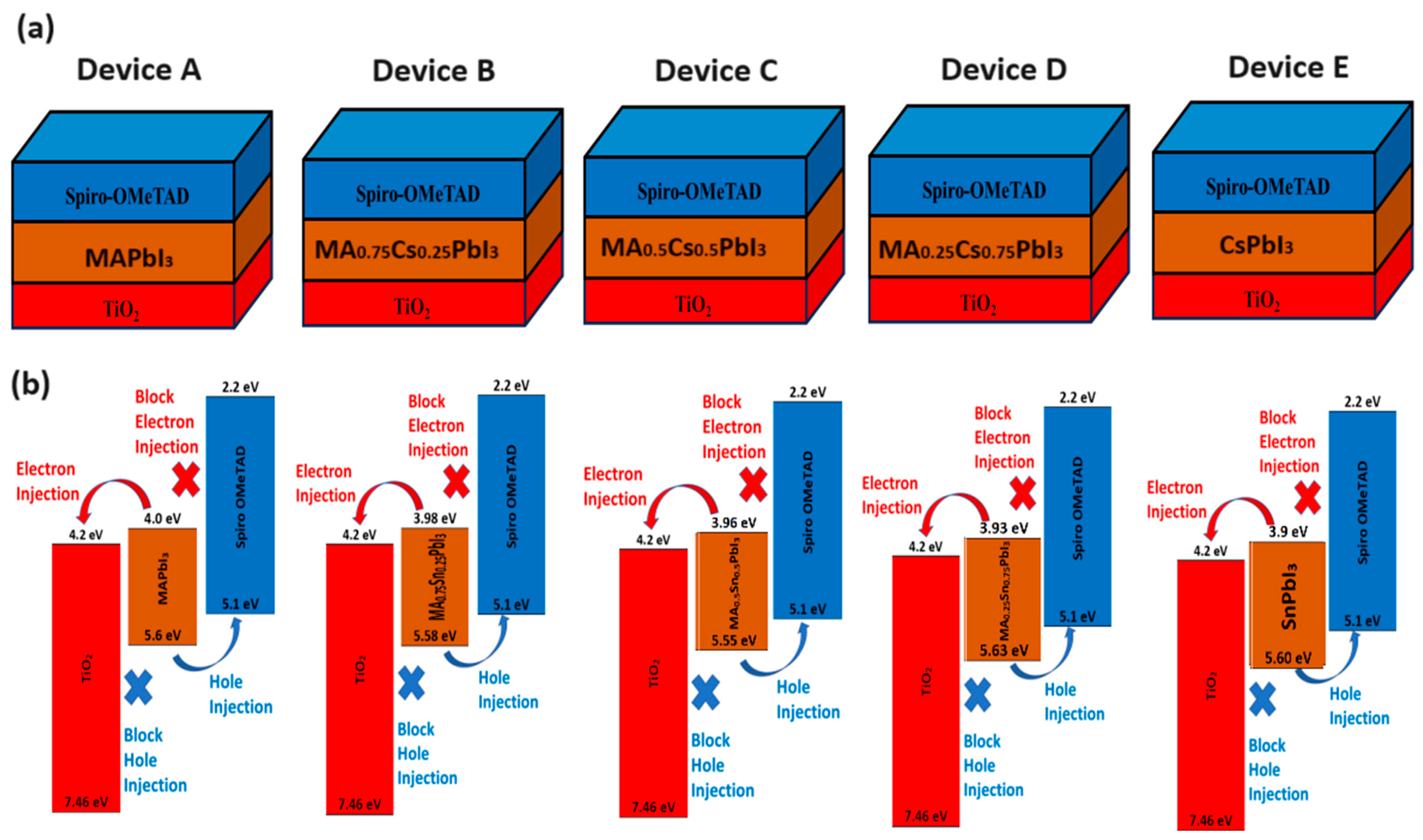

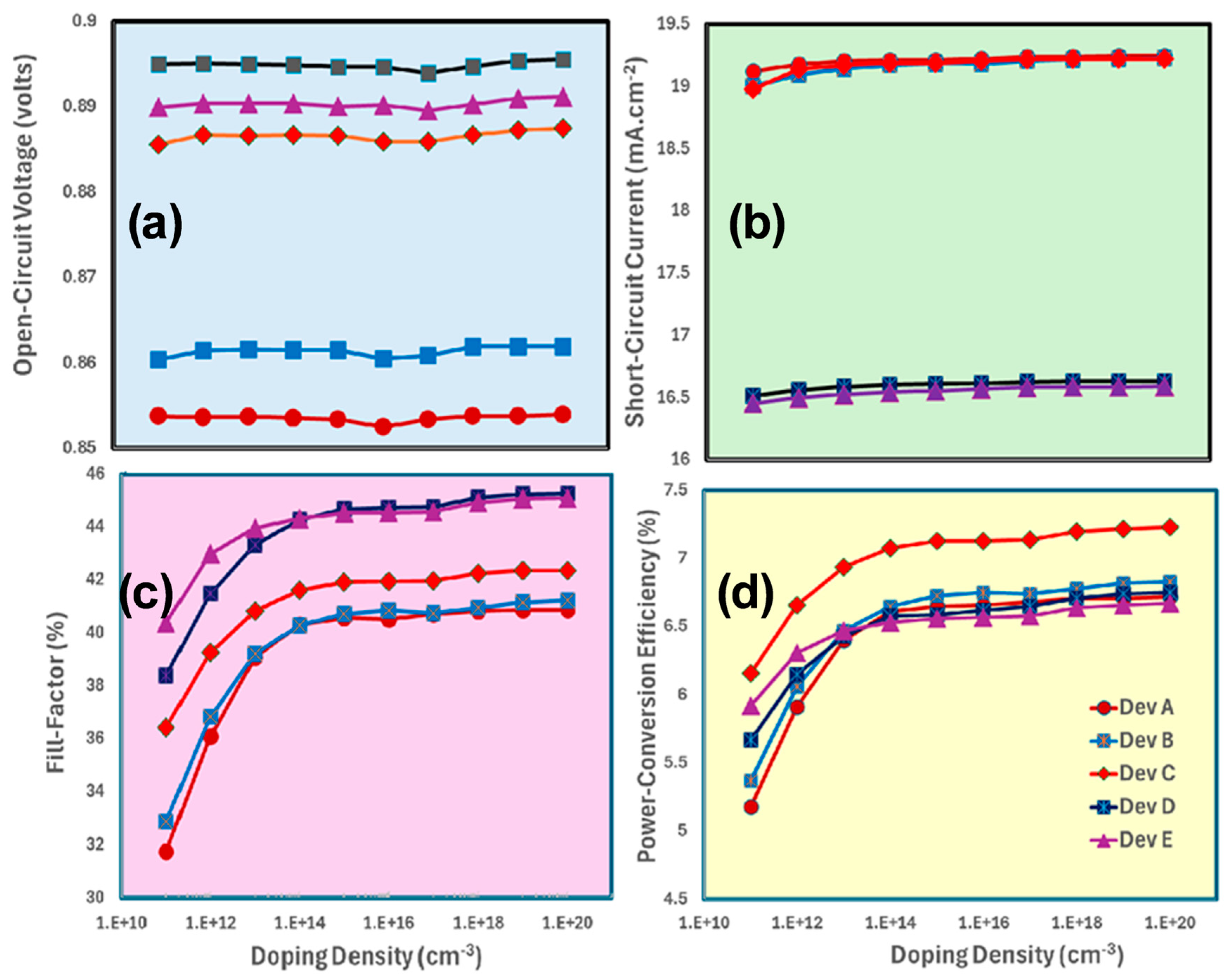
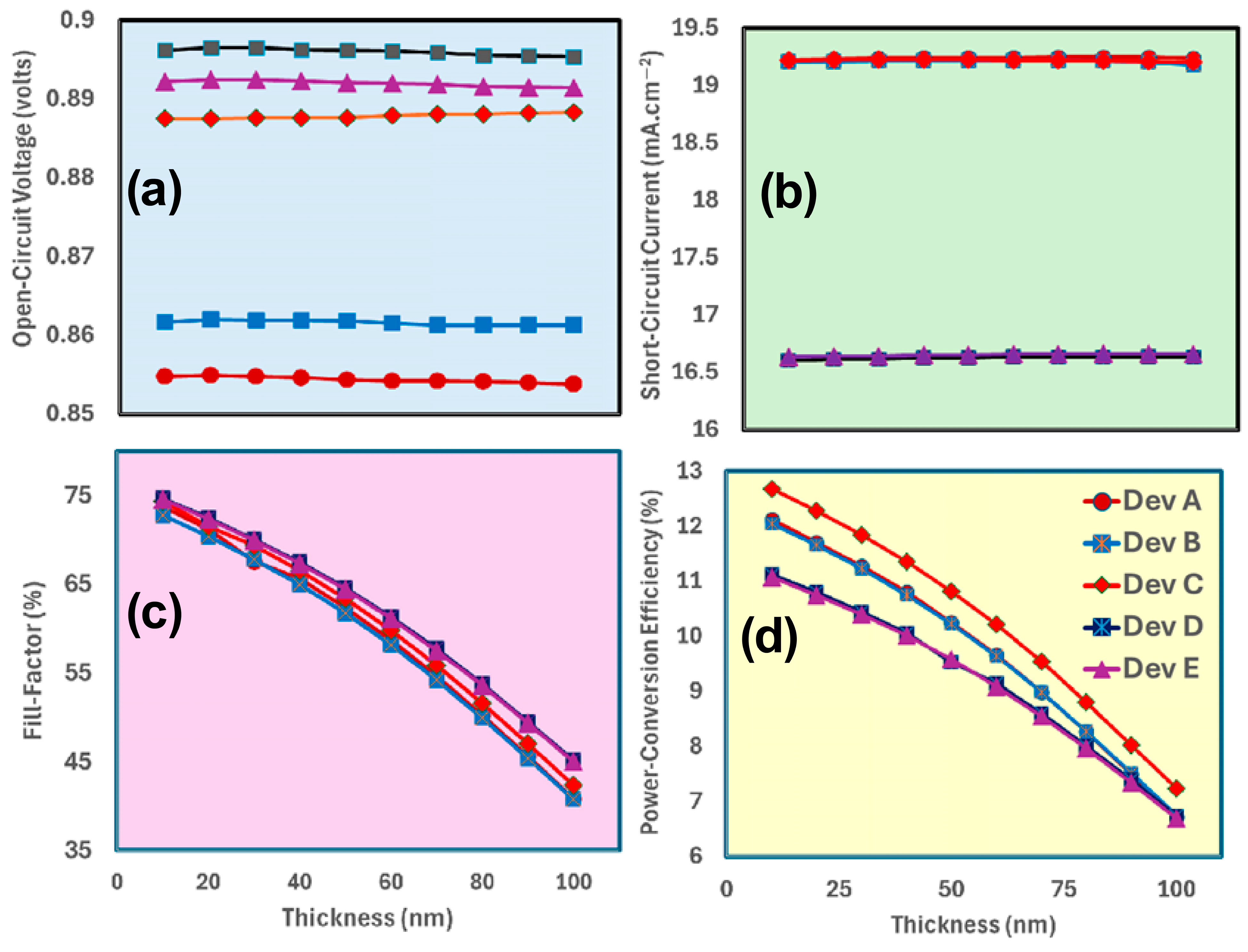


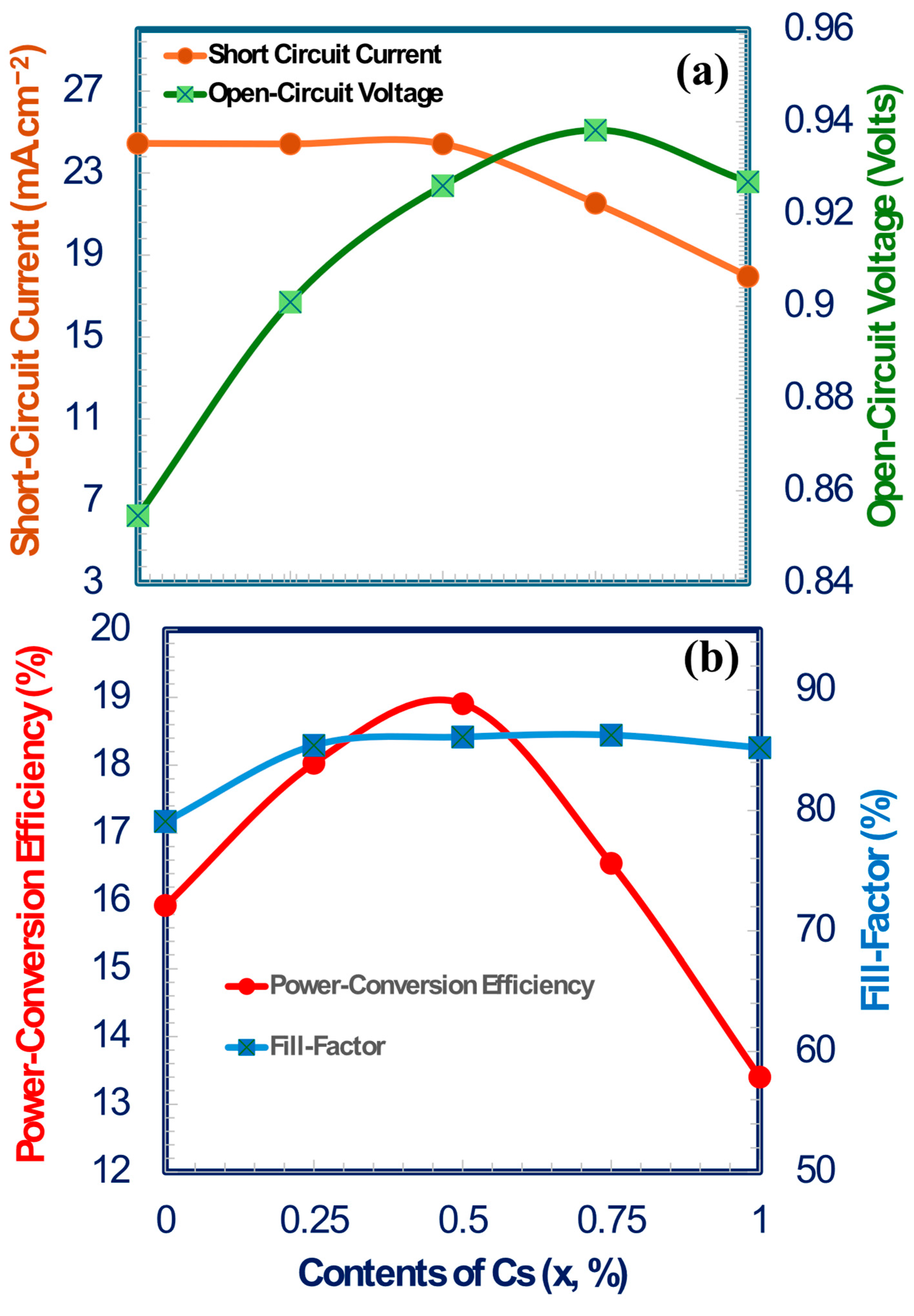
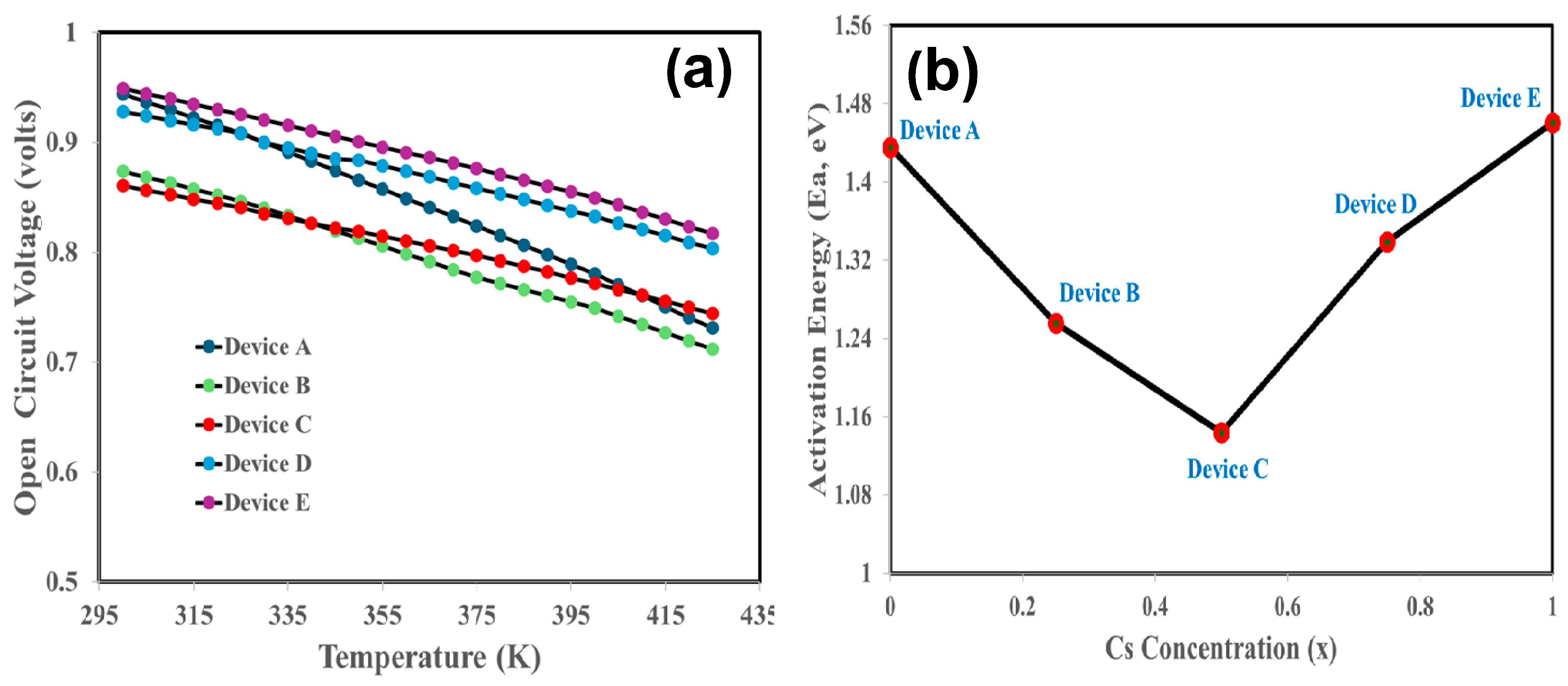
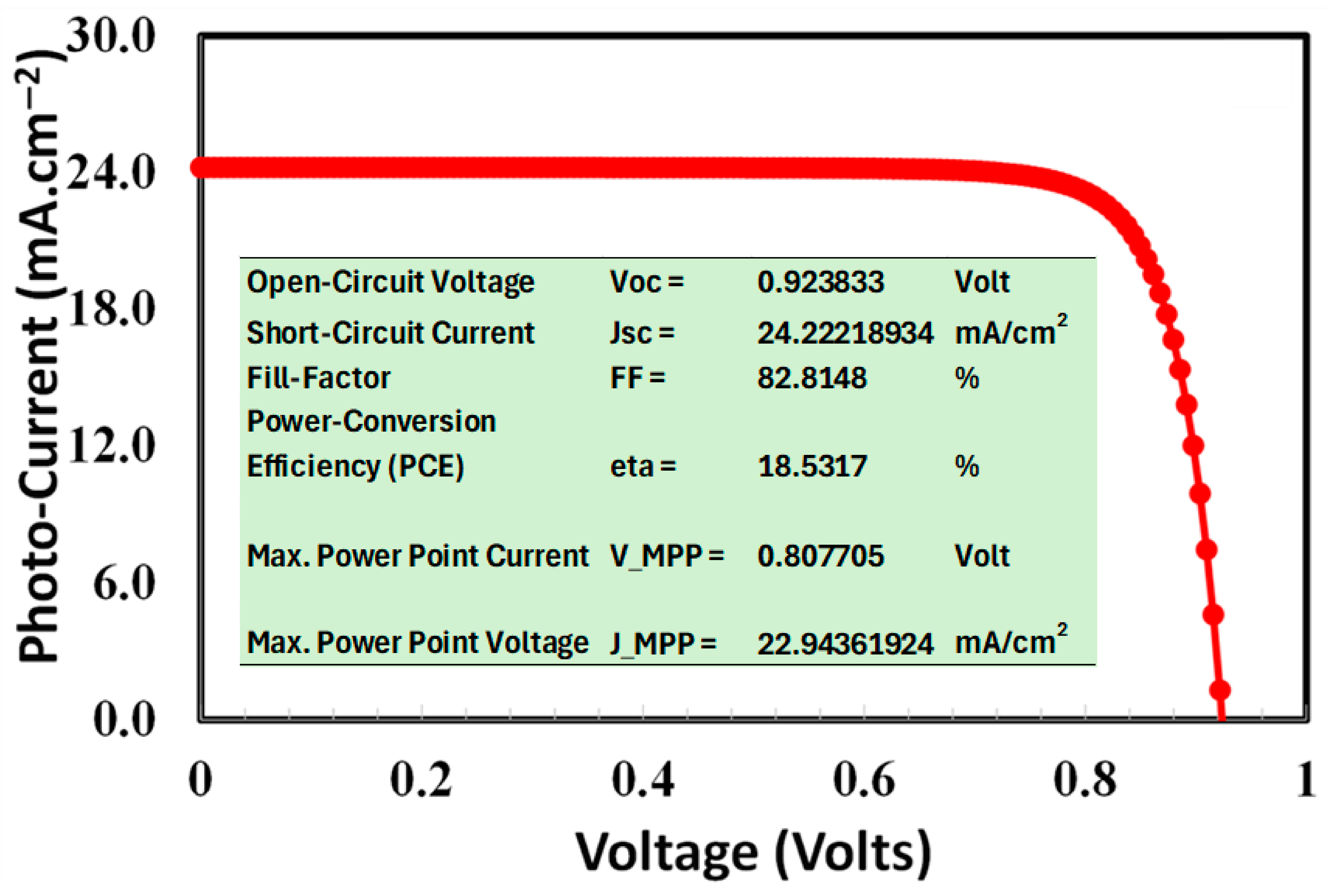
| MA1−xCsxPbI3 | ||||||||||
|---|---|---|---|---|---|---|---|---|---|---|
| Photovoltaic Parameters | Unit | Symbol | ITO | TiO2 | Spiro-MeOTAD | x = 0 | x = 0.25 | x = 0.5 | x = 0.75 | x = 1 |
| Thickness | nm | Th | 100 | 100 | 150 | 300.0 | 300.0 | 300.0 | 300.0 | 300.0 |
| Energy Band Gap | eV | Eg | 3.6 | 3.26 | 2.9 | 1.6 | 1.6 | 1.6 | 1.7 | 1.7 |
| Electron Affinity | eV | Χ | 4.1 | 4.2 | 2.2 | 4.00 | 3.98 | 3.95 | 3.93 | 3.90 |
| Dielectric Permittivity | Ε | 10 | 10 | 3.5 | 6.5 | 6.4 | 6.2 | 6.0 | 6.0 | |
| Effective Density of States at Conduction Band | cm−3 | NC | 2 × 1018 | 2.2 × 1018 | 2.2 × 1018 | 1 × 1020 | 1.5 × 1020 | 1.8 × 1020 | 2.1 × 1020 | 2.5 × 1020 |
| Effective Density of States at Valence Band | cm−3 | NV | 1.8 × 1019 | 1.8 × 1018 | 1.8 × 1019 | 8 × 1020 | 7 × 1020 | 5 × 1020 | 4 × 1020 | 2.5 × 1020 |
| Hole Thermal Velocity | cm/s | Vh | 1 × 107 | 1 × 107 | 1 × 107 | 1 × 107 | 1 × 107 | 1 × 107 | 1 × 107 | 1 × 107 |
| Electron Thermal Velocity | cm/s | Ve | 1 × 107 | 1 × 107 | 1 × 107 | 1 × 107 | 1 × 107 | 1 × 107 | 1 × 107 | 1 × 107 |
| Electron Mobility | cm−2/V·s | µe | 50 | 20 | 1 × 10−4 | 50.0 | 44.0 | 38.0 | 32.0 | 25.0 |
| Hole Mobility | cm−2/V·s | µh | 75 | 10 | 1 × 10−4 | 50.0 | 44.0 | 38.0 | 32.0 | 25.0 |
| Uniform Shallow Donor Doping | cm−3 | ND | 1 × 1019 | 1 × 1017 | 0 | 0.0 | 0.0 | 0.0 | 0.0 | 0.0 |
| Uniform Shallow Acceptor Doping | cm−3 | NA | 0 | 0 | 1 × 1018 | 1 × 1013 | 1 × 1013 | 1 × 1014 | 1 × 1015 | 1 × 1015 |
| Defect Density | cm−3 | NT | 1 × 1015 | 1 × 1015 | 1 × 1015 | 1 × 1015 | 1 × 1015 | 1 × 1015 | 1 × 1015 | 1 × 1015 |
| References | [44] | [44,45,46,47] | [38,47,48,49] | [38,49,50,51,52,53,54,55] | ||||||
| Defect Parameters | Unit | TiO2/MA1−xCsxPbI3 | MA1−xCsxPbI3/Spiro OMeTAD | MA1−xCsxPbI3 |
|---|---|---|---|---|
| Defect Type | - | Neutral | Neutral | Neutral |
| Capture Cross-section for Electron and holes | cm−2 | 1 × 10−14 | 1 × 10−14 | 1 × 10−14 |
| Energetic Distribution | - | Single | Single | Gaussian |
| Energy Level With respect to Ev | eV | 0.6 | 0.6 | 0.65 |
| Characteristics Energy | eV | - | - | 0.1 |
| Total Density | cm−3 | 1 × 1014 | 1 × 1014 | 1 × 1014 |
| Year | Absorber | HTL Material | ETL Material | Voc (V) | Jsc mA·cm−2 | FF (%) | PCE (%) | Ref. |
|---|---|---|---|---|---|---|---|---|
| 2025 | MA0.5Cs0.5PbI3 | Spiro-OMeTAD | TiO2 | 0.92 | 24.22 | 82.8 | 18.53 | This study |
| 2025 | FAPbIxCl3−x (with interface engineering) | - | SnO2 | 1.10 | 24.89 | 80 | 22.89 | [80] |
| 2023 | FA0.5Cs0.5PbI3 | HTL Free | PCBM | 0.98 | 22.63 | 75 | 16.72 | [81] |
| 2023 | FA0.83Cs0.17Pb(I0.6Br0.4)3 | PTAA | C60 | 1.25 | 17.2 | 79 | 17.0 | [82] |
| 2023 | CsPbI2.25Br0.75 | PTAA/MoO3 | SnO2/ZnO | 1.35 | 16.49 | 74.0 | 16.4 | [9] |
| 2022 | Cs0.17FA0.83PbI1.8Br1.2 | Spiro-OMeTAD | SnO2 | 1.15 | 18.47 | 71 | 15.07 | [83] |
| 2021 | FA0.9Cs0.1Pb(I0.94Br0.06)3 | NiO | C60 | 1.01 | 22.7 | 64 | 14.8 | [84] |
| 2021 | FA0.9Cs0.1Pb(I0.94Br0.06)3 | NiO | C60 | 1.03 | 22.2 | 72 | 16.5 | [85] |
| 2021 | FA0.9Cs0.1Pb(I0.94Br0.06)3 | NiO | C60 | 1.03 | 21.0 | 62 | 13.5 | [84] |
| 2021 | FA0.9Cs0.1Pb(I0.94Br0.06)3 | NiO | C60 | 1.08 | 22.0 | 65 | 13.5 | [84] |
| 2020 | MA0.5Cs0.5PbI3 | HTL-free | TiO2 | 0.86 | 9.31 | 32 | 2.56 | [86] |
| 2014 | Cs0.1MA0.9PbI3 | Spiro-OMeTAD | PCBM | 1.05 | 10.10 | 73 | 7.68 | [85] |
| 2016 | MA1−xCsxPbI3 | Spiro-OMeTAD | TiO2 | - | - | - | - | [87] |
| 2017 | MA0.85Cs0.15PbI3 | Spiro-OMeTAD | TiO2 | 1.05 | 20.88 | 69 | 15% | [88] |
| Cs Content (x) | Short-Circuit Current (mAcm−2) | Open-Circuit Voltage (Volts) | Full-Factor (%) | Power-Conversion Efficiency (%) | Comments |
|---|---|---|---|---|---|
| 0 (Pure MA) | Moderate | Low | Moderate | Low | Instability & low Voc |
| 0.5 | High | Higher | High | Highest | Optimal balance |
| 0.75 | Moderate | Highest | High | Moderate | Jsc begins to drop |
| 1.0 (Pure Cs) | Low | Lower than 0.75 | Lower | Lowest | Likely phase instability |
Disclaimer/Publisher’s Note: The statements, opinions and data contained in all publications are solely those of the individual author(s) and contributor(s) and not of MDPI and/or the editor(s). MDPI and/or the editor(s) disclaim responsibility for any injury to people or property resulting from any ideas, methods, instructions or products referred to in the content. |
© 2025 by the authors. Licensee MDPI, Basel, Switzerland. This article is an open access article distributed under the terms and conditions of the Creative Commons Attribution (CC BY) license (https://creativecommons.org/licenses/by/4.0/).
Share and Cite
Moiz, S.A.; Alahmadi, A.N.M.; Alshaikh, M.S. Design Optimization of Cesium Contents for Mixed Cation MA1−xCsxPbI3-Based Efficient Perovskite Solar Cell. Nanomaterials 2025, 15, 1085. https://doi.org/10.3390/nano15141085
Moiz SA, Alahmadi ANM, Alshaikh MS. Design Optimization of Cesium Contents for Mixed Cation MA1−xCsxPbI3-Based Efficient Perovskite Solar Cell. Nanomaterials. 2025; 15(14):1085. https://doi.org/10.3390/nano15141085
Chicago/Turabian StyleMoiz, Syed Abdul, Ahmed N. M. Alahmadi, and Mohammed Saleh Alshaikh. 2025. "Design Optimization of Cesium Contents for Mixed Cation MA1−xCsxPbI3-Based Efficient Perovskite Solar Cell" Nanomaterials 15, no. 14: 1085. https://doi.org/10.3390/nano15141085
APA StyleMoiz, S. A., Alahmadi, A. N. M., & Alshaikh, M. S. (2025). Design Optimization of Cesium Contents for Mixed Cation MA1−xCsxPbI3-Based Efficient Perovskite Solar Cell. Nanomaterials, 15(14), 1085. https://doi.org/10.3390/nano15141085







